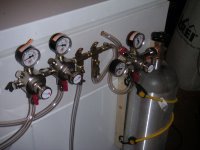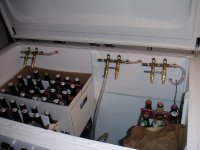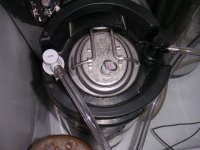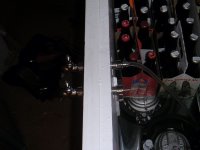Kegerator inauguration
Posted by Nate in Homebrewing, Projects.
Sunday, February 26th, 2006 at 8:59 pm
 Time for an update, and lots more pictures. At left is the trial run to see if my measurements were right and I can actually fit (at least) 8 kegs in this thing – no problem. And I’ve still got the whole compressor shelf which could hold two more or three if I try. Whoa.
Time for an update, and lots more pictures. At left is the trial run to see if my measurements were right and I can actually fit (at least) 8 kegs in this thing – no problem. And I’ve still got the whole compressor shelf which could hold two more or three if I try. Whoa.
 The remaining parts came last week, I think Thursday, so that night was spend knocking together the gas fixtures and manifolds on the back of the rig. You can see (from right to left) the 10# CO2 tank and primary regulator set at 24 psi. At 40 degrees F, 24 psi will give me 3.5 volumes of CO2 in solution – just right for soda and highly carbonated hefeweizens. This pressure is fed into a double manifold so I can drop it inside and also use an external line to force-carbonate kegs or 2-liter bottles by shaking. This double regulator passes the 24 psi right into two secondary (low pressure) regulators, one set at about 14 psi and one at 8 – this will give me nice pressure for standard ales and low carb british and scottish ales.
The remaining parts came last week, I think Thursday, so that night was spend knocking together the gas fixtures and manifolds on the back of the rig. You can see (from right to left) the 10# CO2 tank and primary regulator set at 24 psi. At 40 degrees F, 24 psi will give me 3.5 volumes of CO2 in solution – just right for soda and highly carbonated hefeweizens. This pressure is fed into a double manifold so I can drop it inside and also use an external line to force-carbonate kegs or 2-liter bottles by shaking. This double regulator passes the 24 psi right into two secondary (low pressure) regulators, one set at about 14 psi and one at 8 – this will give me nice pressure for standard ales and low carb british and scottish ales.  All of these lines pass into the kegerator as you can see at left – from left to right we have high pressure, medium, and low. The nice thing with the manifolds is they’re pretty easy to extend when I need to add more gas lines for the rest of the kegs. They also include check-valves, which prevent liquid from flowing back into the regulators if I ever attach a high pressure keg to a low pressure line.
All of these lines pass into the kegerator as you can see at left – from left to right we have high pressure, medium, and low. The nice thing with the manifolds is they’re pretty easy to extend when I need to add more gas lines for the rest of the kegs. They also include check-valves, which prevent liquid from flowing back into the regulators if I ever attach a high pressure keg to a low pressure line.
 Finally we’re at the keg itself, with two quick disconnects feeding CO2 and drawing beer, from left to right. I’m using 3/16 interior diameter beer line for increased resistance – I still need about 5 feet to drop the pressure enough for a good pour. If that’s confusing, just think about shooting beer at 12 psi into a glass – it would explode in foam. The long tube length applies increased pressure over distance, allowing the beer to reach equilibrium before it exits the faucent. There are a lot of crazy formulas to calculate line length based on temperature and serving pressure – my 24 psi lines are going to be a coil about 25 feet long!
Finally we’re at the keg itself, with two quick disconnects feeding CO2 and drawing beer, from left to right. I’m using 3/16 interior diameter beer line for increased resistance – I still need about 5 feet to drop the pressure enough for a good pour. If that’s confusing, just think about shooting beer at 12 psi into a glass – it would explode in foam. The long tube length applies increased pressure over distance, allowing the beer to reach equilibrium before it exits the faucent. There are a lot of crazy formulas to calculate line length based on temperature and serving pressure – my 24 psi lines are going to be a coil about 25 feet long!
 Lastly the glorious exit. The stainless steel shanks bore through the foam and wood and connect right into stainless steel faucets. They’re more expensive than chrome, but they won’t chip or corrode over time with the acidity of the beer. I don’t have any cool tap handles yet, but there is a screw-in insert that matches the tap thread which will let me make my own someday, so I might go that route. In the meantime probably pick up some dirt cheap plastic ones.
Lastly the glorious exit. The stainless steel shanks bore through the foam and wood and connect right into stainless steel faucets. They’re more expensive than chrome, but they won’t chip or corrode over time with the acidity of the beer. I don’t have any cool tap handles yet, but there is a screw-in insert that matches the tap thread which will let me make my own someday, so I might go that route. In the meantime probably pick up some dirt cheap plastic ones.
What’s on tap? So far just an American amber ale, and a keg full of water for experimenting with a few soda recipes. No gas leaks yet, everything is holding pressure well, and I couldn’t be happier with the results so far. Now I just need the in-progress beer batches to hurry up and finish so I can keg them!!
Oh yeah, it’s called the Kegenator. Word.
Similar Posts:
- Caskerator ( March, 2007)
- Kegerator, yo. ( February, 2006)
- It’s a blog! ( July, 2005)
- Kegenator addition ( February, 2007)
- Detox Day 5 ( May, 2006)

February 27th, 2006 at 8:38 am
What a nice job, and the name is great – Kegenator! I can’t believe how much beer you can get in there. And the three types of pressure, too. You are so good at figuring out how to do stuff, and it’s obvious that you love doing it! Can’t wait to see it in action in person.
We’ve just started to realize that making a batch or two of wine means having 30-60 bottles that need to be stored somewhere. We need an ingenious solution (and a basement!)
February 27th, 2006 at 10:08 am
I’m blown away by all the detail that goes into this. How’d you get started brewing your own stuff?
February 27th, 2006 at 1:07 pm
Ok, so a dumb question. Do you brew a batch and then just poor it into a keg?
I vaguely remember the whole physics of liquid in pipes when I used to work for the Soil Conservation Service. If folks wanted to irrigate and needed a long run of pipe, they could end up with very little water at the other end depending on the pipe size and distance. Friction loss I think they called it. Same thing here, right?
February 27th, 2006 at 5:02 pm
Freddie – it had been a distant notion for years, then when I moved to St. Paul there was a homebrew shop down the street… Done and done!
Rick – basically that’s it, and that’s the beauty of kegging! (Of course, I siphon instead of actually pouring it since the splashing would oxidize the beer and make it taste like cardboard…) But apart from cleaning and sanitizing the keg, beer lines and faucets, it’s a huge time saver over bottling. Woo hoo!
February 23rd, 2007 at 4:05 pm
[…] kegenator is almost exactly a year old. It has faithfully poured many a hearty pint in that year, but lately it’s started to […]